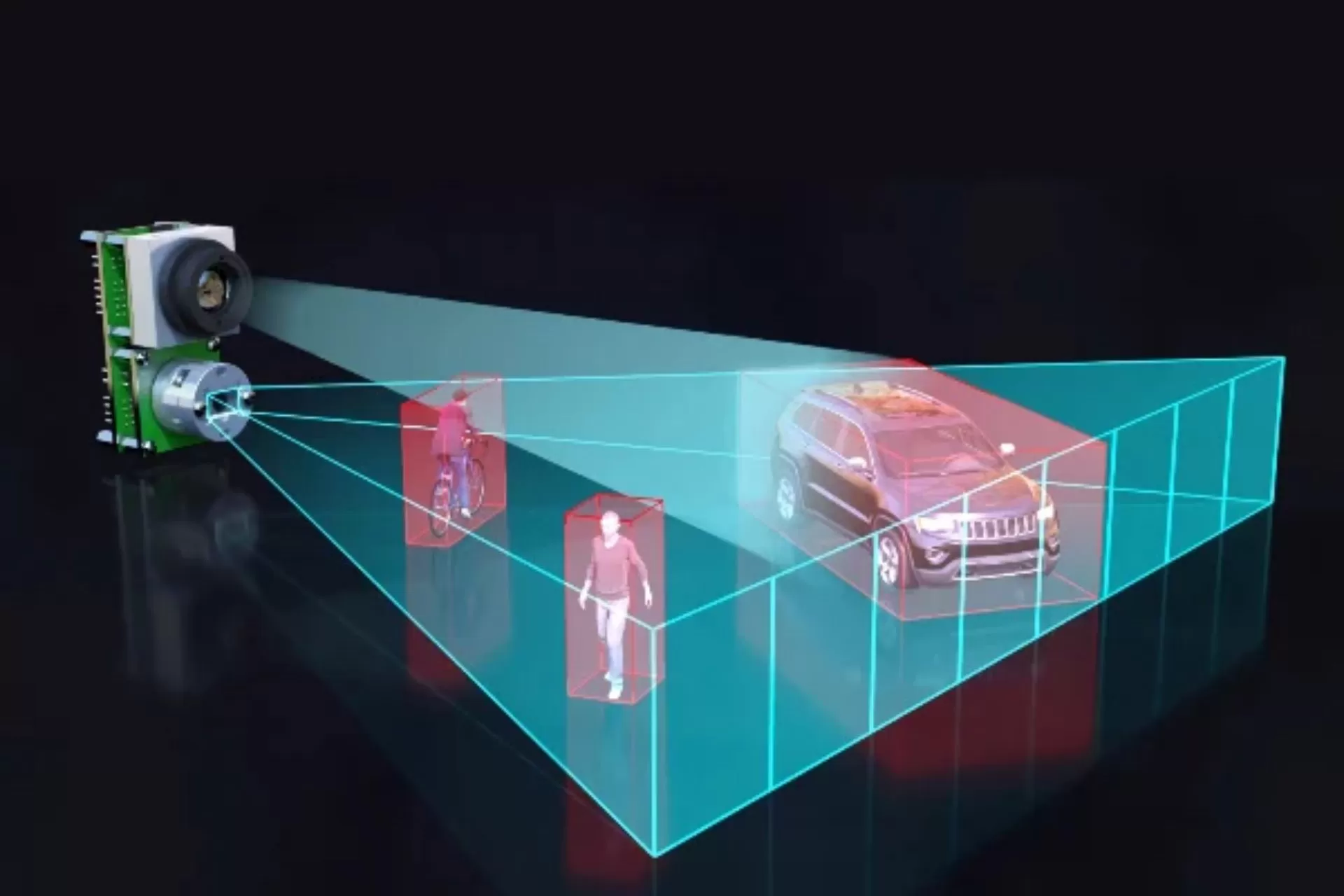
Advancing LiDAR Technology: Enabling Next-generation AR/VR Experiences and Metaverse
Imagine a world where vehicles effortlessly self-navigate, robots explore uncharted territories, ocean floors are mapped while still on land, and ancient secrets are unearthed at the tap of a button. This isn’t the stuff of science fiction; it is the real, tangible impact of LiDAR, a technology set to revolutionize how we live, work, and interact with the world around us.
LiDAR, short for Light Detection and Ranging, emits pulsed laser light and measures its return time, thereby creating a precise 3D rendering of the surveyed area or object. This technique ensures an exceptionally accurate depiction of the environment or target.

Working principle of LiDAR sensor
The fundamental workings of a LiDAR sensor require a laser transmitter that emits short pulses of laser light, which bounce off objects in the environment. The receiver detects the reflected light and measures the time it takes for the light to travel to and from the object, thus determining the distance to the object. This technique, known as time-of-flight (TOF), is one of the LiDAR system variants, alongside frequency-modulated continuous wave (FMCW) and phase shift LiDAR systems.
LiDAR sensors can also be categorized based on their scanning mechanism:
- Mechanical scanning: Employing rotating mirrors or galvanometer-driven scanners, this method guides the laser beam across the target scene, constructing complex 3D maps. However, this system’s downside lies in its sluggishness and reliance on moving parts.
- Flash LiDAR: Emitting a solitary laser pulse that instantly illuminates the entire scene, these systems ensure swift data capture. That said, they can be limited in range and resolution.
- Solid-state scanning: Utilizing microelectromechanical systems (MEMS) mirrors, this approach electronically steers the laser beam, providing faster scanning speeds and a more compact design.
LiDAR sensors can also be classified based on their wavelength:
- Near-infrared (NIR): This is the most common wavelength for LiDAR systems as it offers an adept balance between range, resolution, and safety for the human eye.
- Green LiDAR: More suited for penetrating water and vegetation, this wavelength is useful in bathymetric mapping and forestry applications.
- Ultraviolet (UV) LiDAR: This wavelength can be used for atmospheric studies and detecting certain materials that reflect UV light.
LiDAR applications across industries
Several industries have integrated LiDAR system to enhance existing use cases. And as its cost continues to decrease, we can expect to see LiDAR used in even more innovative and exciting ways.
Self-driving cars
LiDAR is a crucial sensor in self-driving cars that helps them perceive their surroundings and navigate autonomously. By generating 3D maps of the road and identifying vehicles, pedestrians, and obstacles, these sensors contribute significantly to safe navigation without human intervention.
Robotics
The sensor also plays a vital role in robotics helping them navigate surroundings, deliver packages, clean floors and explore disaster zones without human guidance.
Monitoring and planning
LiDAR also plays a pivotal role in the construction industry. It is used in key projects for road planning, environmental monitoring, and managing natural resources to create accurate maps of land and water features. This data is also valuable in monitoring crop health and yield and identifying areas needing irrigation or fertilizer, thus helping farmers maximize their yield and decrease costs.
Surveying and mapping
Along with these use cases, LiDAR is also used to map forests, identify mineral deposits, conduct aerial surveying, map ancient ruins, identify buried structures, generate digital elevation models, map coastlines, and predict storm surge inundation. Architects and interior designers use this system to map their blueprints and streamline tasks such as room planning for enhanced furniture placement, interior design, and home renovation.

Retail industry
LiDAR sensors can improve efficiency in the retail domain by providing real-time insights into how customers move and interact with products, enabling retailers to optimize operations and create personalized experiences. Additional insights include:
- Footfall analysis: Retailers can know exactly how many customers enter their store, where they wander, and how long they linger in specific areas. LiDAR delivers these insights, offering valuable information on shopper behavior and traffic patterns.
- Queue monitoring: LiDAR enables real-time tracking of queue lengths, allowing staff to be deployed efficiently and preventing frustrated customers from abandoning their carts.
- Dwell time analysis: By analyzing LiDAR data, retailers can create heatmaps that reveal “hot” and “cold” zones within the store. This analysis informs decisions on product placement and store layout, enhancing customer flow and attention to specific displays.
When coupled with sales data analysis, these insights empower retailers to make data-driven decisions for improved customer satisfaction and revenue growth.
Manufacturing

LiDAR is transforming the manufacturing landscape by improving logistics and supply chain optimization, additive manufacturing (3D printing), quality control, inventory management, and leveraging augmented reality (AR) for assembly and maintenance. Applications like Polycam are used to scan an object to get a 3D model that can be used for training purposes, planning new manufacturing units, and gaining an in-depth understanding of the tools.
- Automated defect detection: LiDAR scanners can meticulously scan products, identifying imperfections like dents, scratches, or misalignments, eliminating manual inspection, saving time, and reducing human error. While computer vision is currently used to detect defects, LiDAR significantly improves accuracy and efficiency.
- Real-time waste management: Continuous LiDAR monitoring of production lines enables immediate identification and correction of defects, preventing faulty products from advancing in manufacturing and minimizing waste.
- Automated material handling: LiDAR-equipped robots navigate warehouses and factories with remarkable accuracy, efficiently and safely managing the handling and transportation of materials.
- 3D mapping and visualization: LiDAR can generate detailed 3D maps of factory layouts and equipment, facilitating better planning, optimization of workflows, and identification of bottlenecks. Built-in sensors on forklifts, AGVs, and other mobile equipment can detect and avoid obstacles in real-time, preventing accidents and injuries.
- Predictive maintenance: LiDAR can predict potential failures and schedule preventive maintenance by tracking machinery movement and condition, minimizing downtime and production losses.
LiDAR scanner in Apple devices
Apple has integrated digital LiDAR sensors into its iPad Pro models, iPhone 12 Pro, and upcoming Pro devices, enabling users to craft highly realistic, precise 3D renditions of nearby objects and environments. This advancement significantly enhances augmented reality (AR) capabilities and elevates the realism of gaming experiences. Moreover, the LiDAR sensor is pivotal in refining Portrait Mode photography by accurately distinguishing subjects from backgrounds and speeding up autofocus.
Beyond these enhancements, the digital sensor extends its utility to assist visually impaired users in navigating their surroundings, enhancing accessibility. Within the iPhone’s magnifier, the detection mode combines inputs from the camera, LiDAR scanner, and on-device machine learning to offer intelligent functionalities such as people detection, door detection, image descriptions, text detection, and point-and-speak features.
Veterinary healthcare
A New Jersey-based company named 3D Pet Prosthetics uses LiDAR sensors for 3D printing full-limb prosthetics as well as customized parts that help mobilize animals with missing limbs by accurately capturing animal dimensions utilizing a process that’s as simple as taking a video.

Augmented reality
AR leverages handheld devices with LiDAR scanners to run applications that provide directions, identify landmarks, and measure objects. The collected data is also used to build immersive and realistic gaming experiences, allowing the players to interact with the game more naturally.
- Improved object recognition and tracking: LiDAR creates quick and precise 3D maps of surroundings, allowing virtual objects to be placed and interact with real-world elements and enhancing the accuracy of object recognition and tracking. Imagine furniture placement apps superimposing realistic sofas that perfectly fit your living room or virtual creatures hiding behind real-world objects.
- Enhanced occlusion: LiDAR understands depth, so 3D objects are precisely hidden behind real-world obstacles, creating a more believable and interactive experience.
- Improved spatial awareness: LiDAR helps AR applications understand a user’s position and movement in real-time, enabling context-sensitive interactions and navigation. This is used in applications using virtual maps adjusting to your movements as you walk through a room.
- Gesture recognition: LiDAR captures detailed hand and body movements, which is valuable for gesture recognition in AR applications. This enables more natural and intuitive interactions with AR content, enhancing the user interface and experience.
- AR filters: LiDAR integration in mobile devices facilitates better AR filters by scanning the surroundings precisely and transforming the environment with colorful animated lighting and fun visual effects that map to the contours of the space. Applications like Snapchat and Apple Clips are some examples.
- Mapping: Navigation apps use AR to give users turn-by-turn directions, overlaying digital information onto the real-world view. Devices with LiDAR scanners experience this more efficiently as the time to spatial map the surroundings is significantly less.
Virtual reality (VR)
- Through meticulously scanning real-life objects using LiDAR sensors, 3D models are used in apps built for virtual reality headsets in domains like gaming, education and training, healthcare, and simulation in the manufacturing process. This improves visualization and makes the user experience more immersive.
- Through precise user tracking, LiDAR enhances user tracking in VR applications. It can enable more immersive and interactive VR experiences by accurately capturing the user’s movements and gestures.
- Apple’s Vision Pro headset comes with a digital LiDAR scanner that enables the headset to deliver a truly immersive and interactive AR/VR experience by allowing features like spatial mapping, hand tracking, and eye tracking. It also enables AR content consumption and improves the Metaverse and gaming experience.
- With VR simulation, LiDAR sensors enable accurate collision detection and obstacle avoidance capabilities in simulated environments.
Metaverse
- Digital assets and NFTs: The use of LiDAR sensors in scanning real-life objects is pivotal in the Metaverse, contributing to the creation of non-fungible tokens (NFTs). These tokens encompass digital art, collectibles, virtual pets, rare in-game items, and even virtual real estate derived from LiDAR-scanned objects.
- Shared spaces: Leveraging LiDAR sensors, real-life environments are scanned to craft shared spaces within the Metaverse. This immersive experience offers users’ avatars a more familiar and engaging walk-through of these spaces. From offices to heritage sites, commercial venues, educational institutions, museums, and galleries, all can be replicated using LiDAR to create shared, immersive environments.
Challenges and limitations of LiDAR technology
While LiDAR offers remarkable capabilities, it also harbors certain limitations and drawbacks:
- Cost constraints: The expense associated with LiDAR sensors, especially high-performance models, poses a barrier to their widespread adoption across applications.
- Limited range: Despite advancements, LiDAR systems still have a constrained range compared to technologies like radar, restricting their effectiveness in applications requiring long-distance sensing.
- Resolution challenges: Factors such as pulse duration and scanning mechanisms can limit LiDAR’s resolution, impacting the accuracy of object recognition and interpretation.
- Sensitivity to environmental conditions: LiDAR performance can be affected by weather conditions like fog, rain, and dust, limiting its effectiveness in outdoor applications during harsh weather.
- Vulnerability to interference: LiDAR can be susceptible to interference from other light sources, affecting the data’s accuracy.
- Limited color information: While some advanced LiDAR systems can capture color data, many only rely on intensity information, limiting their ability to characterize objects fully.
- Dependence on external data: In many applications, LiDAR often needs to be combined with other sensor data like GPS and IMUs for accurate positioning and interpretation.
Zensar’s pioneering work with LiDAR
At Zensar, groundbreaking advancements in AR technology involve harnessing LiDAR sensing for an innovative inventory dimensioning application. This cutting-edge solution scans objects precisely, extracting accurate dimensions that streamline packaging requirements. Zensar’s utilization of LiDAR extends to meticulous object scanning, resulting in intricate 3D models. These models undergo a refinement process, converting raw data into pristine assets ready for integration into AR/VR experiences or integration within the Metaverse.
Despite its limitations, LiDAR remains a powerful technology with significant potential across industries. Continuous research and development can help address the limitations and expand its capabilities, paving the way for a future where LiDAR plays an even more transformative role.
Reference Links:
- www.usgs.gov/
- www.3dpetsprosthetics.com/
- www.poly.cam/
- www.neonscience.org/resources/learning-hub/tutorials/lidar-basics#:~:text=In%20a%20LiDAR%20system%2C%20light,sensor%20where%20it%20is%20recorded
- www.developer.apple.com/documentation/avfoundation/additional_data_capture/capturing_depth_using_the_lidar_camera



